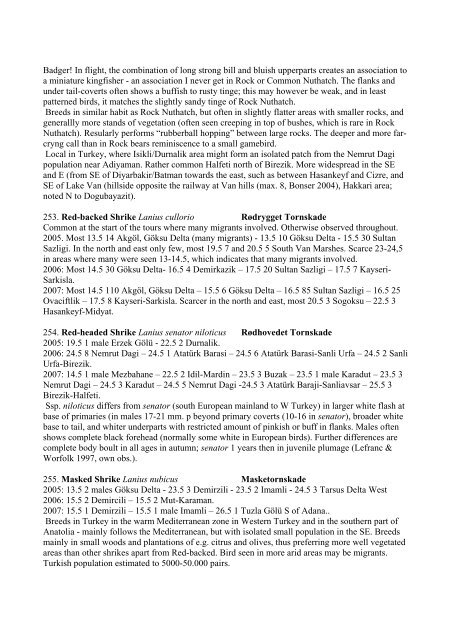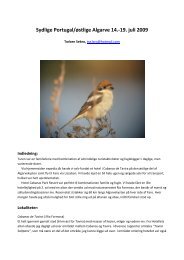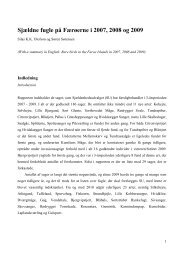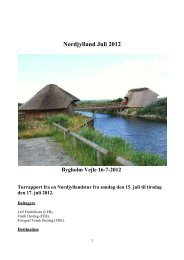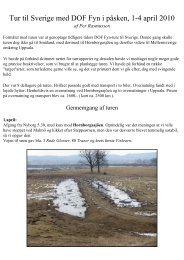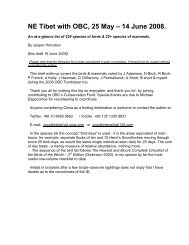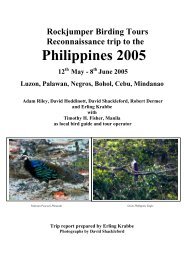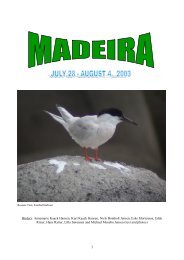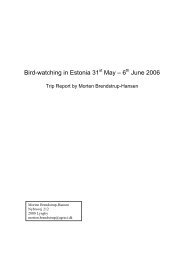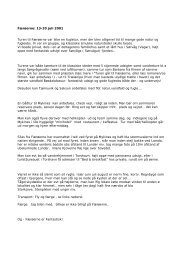TURKEY - a report from a birdwatching trip to Central ... - Netfugl.dk
TURKEY - a report from a birdwatching trip to Central ... - Netfugl.dk
TURKEY - a report from a birdwatching trip to Central ... - Netfugl.dk
You also want an ePaper? Increase the reach of your titles
YUMPU automatically turns print PDFs into web optimized ePapers that Google loves.
Badger! In flight, the combination of long strong bill and bluish upperparts creates an association <strong>to</strong><br />
a miniature kingfisher - an association I never get in Rock or Common Nuthatch. The flanks and<br />
under tail-coverts often shows a buffish <strong>to</strong> rusty tinge; this may however be weak, and in least<br />
patterned birds, it matches the slightly sandy tinge of Rock Nuthatch.<br />
Breeds in similar habit as Rock Nuthatch, but often in slightly flatter areas with smaller rocks, and<br />
generallly more stands of vegetation (often seen creeping in <strong>to</strong>p of bushes, which is rare in Rock<br />
Nuthatch). Resularly performs “rubberball hopping” between large rocks. The deeper and more farcryng<br />
call than in Rock bears reminiscence <strong>to</strong> a small gamebird.<br />
Local in Turkey, where Isikli/Durnalik area might form an isolated patch <strong>from</strong> the Nemrut Dagi<br />
population near Adiyaman. Rather common Halfeti north of Birezik. More widespread in the SE<br />
and E (<strong>from</strong> SE of Diyarbakir/Batman <strong>to</strong>wards the east, such as between Hasankeyf and Cizre, and<br />
SE of Lake Van (hillside opposite the railway at Van hills (max. 8, Bonser 2004), Hakkari area;<br />
noted N <strong>to</strong> Dogubayazit).<br />
253. Red-backed Shrike Lanius cullorio Rødrygget Tornskade<br />
Common at the start of the <strong>to</strong>urs where many migrants involved. Otherwise observed throughout.<br />
2005. Most 13.5 14 Akgöl, Göksu Delta (many migrants) - 13.5 10 Göksu Delta - 15.5 30 Sultan<br />
Sazligi. In the north and east only few, most 19.5 7 and 20.5 5 South Van Marshes. Scarce 23-24,5<br />
in areas where many were seen 13-14.5, which indicates that many migrants involved.<br />
2006: Most 14.5 30 Göksu Delta- 16.5 4 Demirkazik – 17.5 20 Sultan Sazligi – 17.5 7 Kayseri-<br />
Sarkisla.<br />
2007: Most 14.5 110 Akgöl, Göksu Delta – 15.5 6 Göksu Delta – 16.5 85 Sultan Sazligi – 16.5 25<br />
Ovaciftlik – 17.5 8 Kayseri-Sarkisla. Scarcer in the north and east, most 20.5 3 Sogoksu – 22.5 3<br />
Hasankeyf-Midyat.<br />
254. Red-headed Shrike Lanius sena<strong>to</strong>r niloticus Rødhovedet Tornskade<br />
2005: 19.5 1 male Erzek Gölü - 22.5 2 Durnalik.<br />
2006: 24.5 8 Nemrut Dagi – 24.5 1 Atatürk Barasi – 24.5 6 Atatürk Barasi-Sanli Urfa – 24.5 2 Sanli<br />
Urfa-Birezik.<br />
2007: 14.5 1 male Mezbahane – 22.5 2 Idil-Mardin – 23.5 3 Buzak – 23.5 1 male Karadut – 23.5 3<br />
Nemrut Dagi – 24.5 3 Karadut – 24.5 5 Nemrut Dagi -24.5 3 Atatürk Baraji-Sanliavsar – 25.5 3<br />
Birezik-Halfeti.<br />
Ssp. niloticus differs <strong>from</strong> sena<strong>to</strong>r (south European mainland <strong>to</strong> W Turkey) in larger white flash at<br />
base of primaries (in males 17-21 mm. p beyond primary coverts (10-16 in sena<strong>to</strong>r), broader white<br />
base <strong>to</strong> tail, and whiter underparts with restricted amount of pinkish or buff in flanks. Males often<br />
shows complete black forehead (normally some white in European birds). Further differences are<br />
complete body boult in all ages in autumn; sena<strong>to</strong>r 1 years then in juvenile plumage (Lefranc &<br />
Worfolk 1997, own obs.).<br />
255. Masked Shrike Lanius nubicus Maske<strong>to</strong>rnskade<br />
2005: 13.5 2 males Göksu Delta - 23.5 3 Demirzili - 23.5 2 Imamli - 24.5 3 Tarsus Delta West<br />
2006: 15.5 2 Demircili – 15.5 2 Mut-Karaman.<br />
2007: 15.5 1 Demirzili – 15.5 1 male Imamli – 26.5 1 Tuzla Gölü S of Adana..<br />
Breeds in Turkey in the warm Mediterranean zone in Western Turkey and in the southern part of<br />
Ana<strong>to</strong>lia - mainly follows the Mediterranean, but with isolated small population in the SE. Breeds<br />
mainly in small woods and plantations of e.g. citrus and olives, thus preferring more well vegetated<br />
areas than other shrikes apart <strong>from</strong> Red-backed. Bird seen in more arid areas may be migrants.<br />
Turkish population estimated <strong>to</strong> 5000-50.000 pairs.


